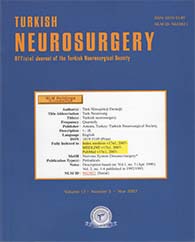3Fırat University, Radiology, Elazığ, Turkey OBJECTIVE: In the present study, the clinical effectiveness of a surgical procedure in which no draining tubes are installed following simple burr hole drainage and saline irrigation is investigated.
METHODS: 10 patients, having undergone operative intervention for unilateral chronic subdural hemorrhage, having a clinical grade of 2 and a hemorrhage thickness of 2 cm, were included in the study. The cerebral blood flow rates of middle cerebral artery were evaluated bilaterally with Doppler before and after the surgery. All the cases underwent the operation using the simple burr hole drainage technique without the drain and consequent saline irrigation. Statistical analysis was performed by Wilcoxon signed rank test (p<0,05).
RESULTS: There was a pronounced decrease in the preoperative MCA blood flow in the hemisphere the hemorrhage had occurred (p=0,008). An increased PI value on the side of the hemorrhage drew our attention (p=0,005). Postoperative MCA blood flow measurements showed a statistically significant improvement (p=0,005). Furthermore, the PI value showed normalization (p<0,05). The paresis and the level of consciousness improved in all cases.
CONCLUSION: Simple burr hole drainage technique is sufficient for the improvement of cerebral blood flow and clinical recovery in patients with chronic subdural hemorrhage.
Keywords : Chronic subdural hemorrhage, Cerebral blood flow rates, Simple burr hole drainage, Transcranial doppler ultrasound




